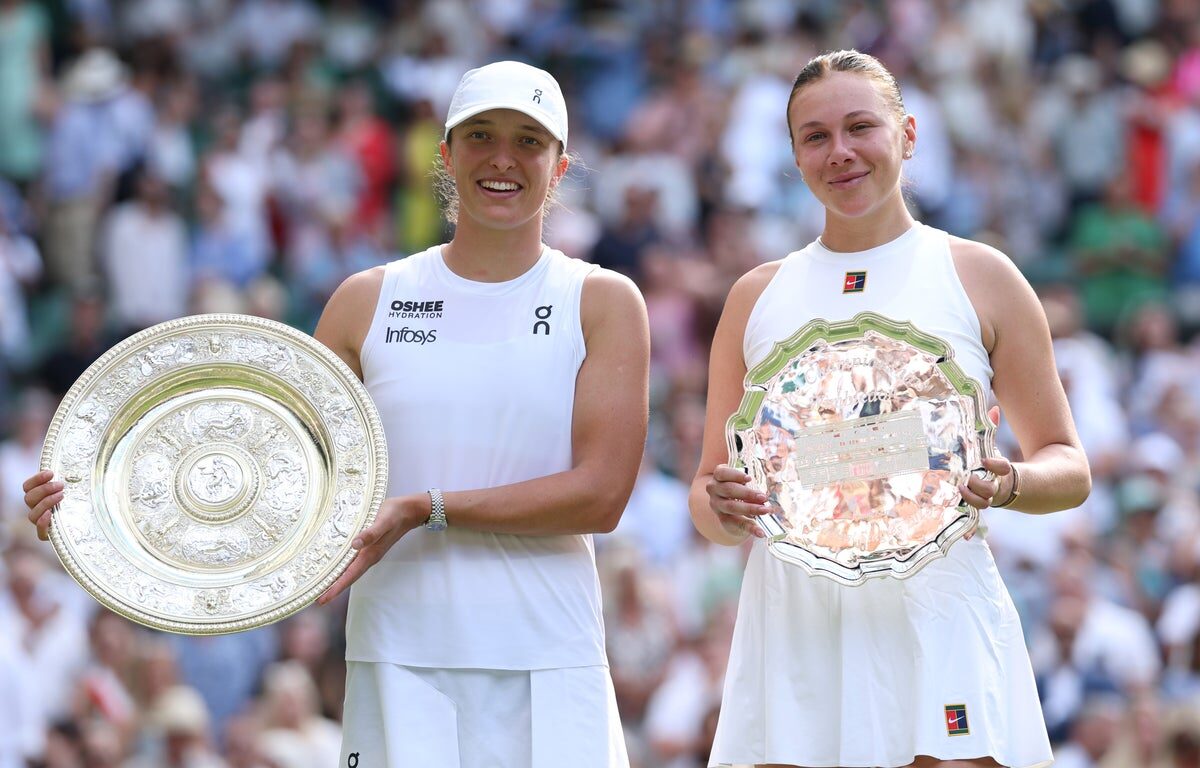It took the Centre Court crowd two points to begin rooting for Amanda Anisimova, after sensing some early nerves in her shaky serving arm. By the third, with the American facing three break points at 0-40, the crowd’s cheers had dissipated into a hum of whispered concern. Iga Swiatek quickly sealed the break, and Anisimova’s nightmare had begun.
It was arguably the worst set of tennis in Wimbledon’s long history of finals, perhaps of any grand slam final. She served three double faults and put only 33 per cent of first serves in (Swiatek landed 80 per cent); most tellingly, she made an eye-watering 14 unforced errors in just six games (Swiatek made only two). Anisimova won nine points in 25 minutes and lost 27.
Centre Court was in shock. There was a violence to what they had witnessed, in the way Anisimova was left alone and exposed trying to field Swiatek’s arsenal but without any of the weapons she deployed in her semi-final, as if she’d dropped them on the long walk to the grass. The balanced footwork and booming backhand that downed the No 1 seed Aryna Sabalenka were gone, replaced by heavy legs and a broken radar. The forehand abandoned her, too, replaced by limp flops into the net.

The second set was slightly more competitive as Anisimova engineered a few more sniffs. But she couldn’t convert them, and at the other end, Swiatek was ruthless, clenching her fist in celebration like she was in a tense tie-break when the scoreboard showed 6-0, 4-0, 15-40. Swiatek finished off the match with a backhand winner down the tramline.
They shared a hug at the net and then they were off in different directions. Swiatek bounding up into the stands to embrace her family and support team, Anisimova slumped in her seat with a towel draped over her head, wanting to wake up. She walked off the court, and when she returned a few moments later, she was wiping the tears from her eyes.
Anisimova handled the obligatory on-court interview with grace, fighting through the emotion to thank her family who were overflowing in her box, including her mum, who flew in overnight to be by her side. “I would definitely not be standing here without you,” she said. “My mum’s put in more work than I have, honestly. She’s done everything to get me to this point in my life.”


Anisimova was the US prodigy winning junior titles and on course to be America’s next star. However, her father’s sudden death – she was only 17 and he was her coach – took an enormous toll, as did the rigours of the professional tour’s relentless churn. She quit tennis for eight months in 2023, citing burnout, saying the constant competition had become “unbearable”.
It was a brave move that saw her tumble from No 23 to No 359 in the world, but a risk that came off with her results this year, winning a first WTA title in Qatar before this deep run at Wimbledon. This scoreline will follow her wherever she goes, but you suspect Anisimova will harness it as a valuable learning experience in what was her first grand slam final.
“I know I didn’t have enough today, but I’ll keep putting in the work,” she said. “I’ll keep believing in myself, and I hope to be back here one day.”
The stark result – the first 6-0, 6-0 in the Wimbledon women’s final since 1911 – almost overshadowed Swiatek’s achievement and her mastery of grass. On her least favourite surface at a tournament where she had not been past the quarter-finals before, Swiatek took charge of Centre Court, finding the lines with her groundstrokes, leaving Anisimova to swipe at little plumes of white dust where the ball had been and gone.
Swiatek is now a six-time grand slam champion, with major titles on all three surfaces. Only seven other players have achieved those two feats in the open era. That she has done it at only 24 years old is remarkable.
“I didn’t even dream about this [winning Wimbledon] because it felt too far away,” she said. “I feel like I am an experienced player, but I never expected this win. My team believed in me more than I did.”


Swiatek has had to overcome her challenges, having accepted a one-month ban last year after testing positive for trimetazidine (TMZ) during an out-of-competition urine sample. She was deemed to have been at “no significant fault” after proving that a batch of sleeping tablets she had been taking were contaminated. She described the ordeal as a “nightmare”, while her unimpeachable reputation was questioned, and the words “positive doping test” will now forever be written into her Wikipedia entry.
The saga understandably entwined with her drop in form and ranking, falling to world No 8, her lowest point in three years. There have been times this year when she has been searching to rediscover her A game, but there were also signs of life in her runs to the semi-finals in Melbourne and Paris, as well as the final of her grass-court warm-up tournament in Bad Homburg last month.
Here it all came together, serving with power, moving her feet and striking the ball beautifully throughout the fortnight. Perhaps London’s heatwave helped slow down the courts, giving her a touch more time and a touch more bounce to play with, to unleash her topspin. This match may be remembered as the day Anisimova failed to win a game, but it was also a landmark victory by the greatest player of her generation.

